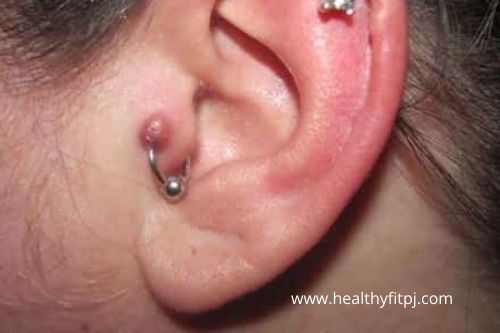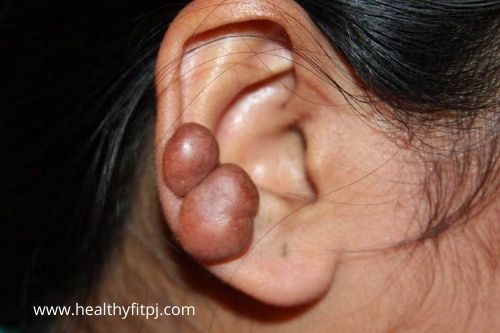Nowadays, piercings are becoming more popular, some people get them for spiritual purposes and others purely for aesthetic reasons. There are lots of reasons that people enjoy getting a new piercing, but it is also important to know how harmful your piercer is. There are a handful of issues that can arise like hypertrophic Bumps (piercing bump), keloid scarring.
Let’s look at these two individual issues, as there is a lot of confusion surrounding them. Although piercing bumps and keloids scars can look similar, they are actually very different.
So, read the article till the end, we explain what keloids and piercing bumps are and how to tell the difference between them. Also, you will know how to treat both.
- Also Read : Permanent Retainers: Pros, Cons, Costs and How Long Does It Last?
- Also Read : How to Get Rid of Matted Hair Clumps and Prevent Matted Hair
Table of Contents
What are Piercing Bumps?

The piercing bumps are very common and surprisingly easy to heal. These particular bumps are small lumps that can appear after a piercing. They often occur following cartilage piercings, such as upper ear piercings or nose piercings.
These piercing bumps are arriving when the body’s immune system responds to the wound and initiates the healing response. This response leads to inflammation.
However, piercing bumps can also be caused by genetics, allergies, lack of aftercare, sleeping on the fresh piercing, poor aftercare, or just bad luck.
A person may experience:
- Bleeding
- Bruising
- Redness
- Mild pain
These symptoms may be experienced in the first few weeks after getting it, and these are all normal. With the proper treatment, they can disappear completely.
What are Keloids?

Keloid is an excessive amount of scar tissue that grows above the skin and covers a larger area. It is a raised scar that occurs as a result of physical trauma, surgery or injury to the skin. in some cases, this type of scar appears after a piercing.
A keloid occurs due to an overgrowth of fibrous tissue and it is actually a medical condition. So, it is best to check if any of your family members have ever received a keloid scar from an injury, piercing or even acne pox or chickenpox.
A keloid that causes excess scar tissue to build up above the skin, and it can take 5 to 12 months to develop after the original injury. In the starting they can be red, pink, purple and typically become darker over the time and cover more surface area as time goes.
Keloid can be extremely painful and itchy. The keloid appearance can be depending on the person’s skin tone and location of the keloid.
What Causes Keloids?
The causes for keloid are not completely understood, but there is some evidence that several factors play an important role in keloid development includes:
- Inflammation
- Skin injuries
- Mechanical stress
- Abnormal wound healing
- Surgery
Piercing Bump vs Keloid: How to Tell the Difference
Piercing bumps and keloids can look similar, but they are actually very different. Here are some main key differences between these skin changes.
| Piercing bump | Keloid | |
| Location | Around the piercing site | Around the piercing site but can extend beyond it |
| Size | Soon after a piercing | Takes about 3–12 months after piercing |
| Formation | Varies, but after forming, it does not grow bigger | May start small and grow bigger over time goes |
| Color | Pink or flesh-colored | Red, pink, purple, but it can become darker over time |
Treatment for Piercing Bumps
Piercing bumps do not typically require treatment because they are part of the body’s natural response to injury. However, you can take some simple steps to keep the area clean and prevent infections.
The steps include:
- Wash your hands before touching the piercing.
- Wash your piercing with gentle soap and water once a day.
- Keeping you piercing jewelry in for at least 6 weeks, without removing or changing it.
- Patting the area dry with a clean pad after showering and avoiding using a towel.
Treatment for Keloid
There are many treatment options available for keloids, the proper treatment option can depend on the size and type of the keloid. Below are some treatment options including:
- Surgery: surgery can remove the keloid, but it can be returned even after surgical removal.
- Laser treatment: laser treatment can remove the keloid scar and make it fade.
- Corticosteroids: this kind of medicine can help shrink the keloid. The American Academy of Dermatology Association notes that people require about four injections on average, having one injection every 3-4 weeks.
- Cryotherapy: this treatment is best used on small keloids, during this treatment doctors freeze the keloid to soften it and reduce the size of keloid. This treatment is not suitable for those who have darker skin, because it can lead to skin pigmentation changes.
When You Should See a doctor
At the first sign of redness, tender, thickening firm bumps or raised areas within a scar, then see your surgeon or dermatologist for treatment and try to keep the scar as soft and flat as possible.
If you know that you have a keloid, then you should speak with a doctor or dermatologist because without treatment, the keloid may continue to grow.
If you’re experiencing any kind of symptoms of an infection, you should also seek the advice of a doctor.
FAQ’s
-
Should I Take Out My Piercing if I Have a Keloid?
Piercing can slow the healing process and further irritate the skin. so, don’t remove the piercing, because it can cause the hole to close up and trap the infection.
-
Will the Bump on My Piercing Go Away?
Piercing bumps may be caused by genetics, allergies, or even poor aftercare. With the best treatment they can disappear completely.
-
How Long Does a Piercing Bump Take to Go Away?
The short answer is within 2 or 3 days of treatment. When you see a doctor or piercer, it can take several weeks to fully heal the area, but for some cases, you should see improvement within 2 to 3 days of treatment.
Conclusion
There is a lot of misinformation available online, so it is best to visit your piercer in person if you are unsure of anything related to your fresh piercing.
However, piercing bumps and keloids are two different skin conditions – piercing bumps can appear more quickly and do not grow in size, and are relatively easy to treat. While keloids take a lot of time to appear and can continue to grow over time.
If you feel that you have a keloid or another condition that may be causing a lump, then you should speak with a doctor or healthcare provider.
Hopefully, you like this article, if you have any questions and suggestions kindly put them in the comment box below.
You’ll also like:
